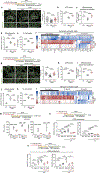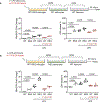Fragmented mitochondria released from microglia trigger A1 astrocytic response and propagate inflammatory neurodegeneration
- PMID: 31551592
- PMCID: PMC6764589
- DOI: 10.1038/s41593-019-0486-0
Fragmented mitochondria released from microglia trigger A1 astrocytic response and propagate inflammatory neurodegeneration
Erratum in
-
Author Correction: Fragmented mitochondria released from microglia trigger A1 astrocytic response and propagate inflammatory neurodegeneration.Nat Neurosci. 2021 Feb;24(2):289. doi: 10.1038/s41593-020-00774-5. Nat Neurosci. 2021. PMID: 33324000 No abstract available.
Abstract
In neurodegenerative diseases, debris of dead neurons are thought to trigger glia-mediated neuroinflammation, thus increasing neuronal death. Here we show that the expression of neurotoxic proteins associated with these diseases in microglia alone is sufficient to directly trigger death of naive neurons and to propagate neuronal death through activation of naive astrocytes to the A1 state. Injury propagation is mediated, in great part, by the release of fragmented and dysfunctional microglial mitochondria into the neuronal milieu. The amount of damaged mitochondria released from microglia relative to functional mitochondria and the consequent neuronal injury are determined by Fis1-mediated mitochondrial fragmentation within the glial cells. The propagation of the inflammatory response and neuronal cell death by extracellular dysfunctional mitochondria suggests a potential new intervention for neurodegeneration-one that inhibits mitochondrial fragmentation in microglia, thus inhibiting the release of dysfunctional mitochondria into the extracellular milieu of the brain, without affecting the release of healthy neuroprotective mitochondria.
Conflict of interest statement
Competing Interests
Patents on P110 and its utility in HD, ALS and other neurodegenerative diseases have been filed by D.M‐R and A.U.J. The other authors declare that they have no conflict of interest.
Figures








References
Publication types
MeSH terms
Substances
Grants and funding
LinkOut - more resources
Full Text Sources
Other Literature Sources
Molecular Biology Databases
Research Materials

